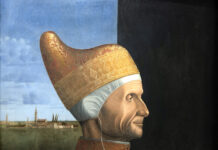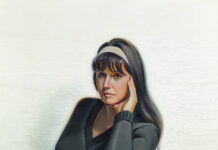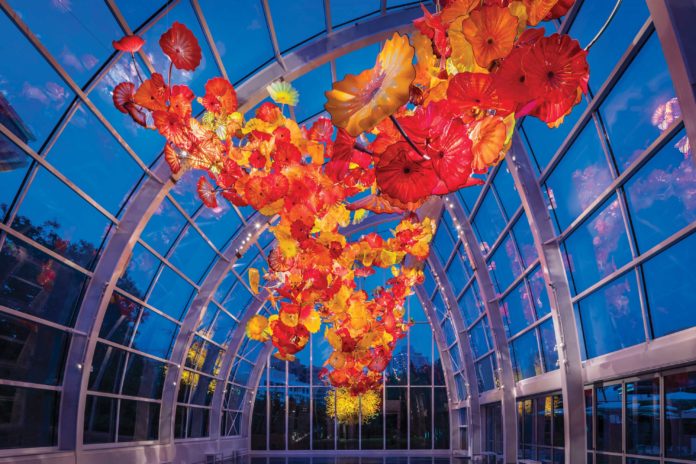
The Seattle-based artist Dale Chihuly (b. 1941) is known worldwide for colorful, expressive creations in glass that have — during his five-decade career — revolutionized our understanding of this material, which had long been discounted by connoisseurs of fine art as “merely” decorative or industrial. Through his efforts, glass has become another legitimate medium in the field of sculpture, as integral to it as bronze or clay. Chihuly’s work has grown in scale as production technologies become more sophisticated, and he continues to draw inspiration from diverse aesthetic traditions, including those of Italy, Ireland, Japan, the Czech Republic, and the Middle East.
Glass has always captivated us — for its translucency, for its familiarity, for the thrilling possibility that it can shatter — yet Dale Chihuly has empowered it to excite even more people through his compelling arrangements. Given the general perception that Chihuly is a maximalist who adores bright colors and soaring heights, it may seem odd to align him with the minimalist movement that arose in the late 1960s.
In fact, his repetitive use of an industrially produced element (glass) does link him to canonical minimalists like Donald Judd, who stacked and wall-mounted steel boxes painted with enamel. Perhaps more evident is Chihuly’s link to the movement of process art, with its emphasis on non-traditional materials and the act of creation, rather than on the finished product as a precious, irreplaceable treasure. (Chihuly’s crew members never fret when a piece of glass breaks during installation; they always bring along extras.)
And surely no one can miss the role Dale Chihuly has played in our era’s embrace of installation art. Of his monumental, site-specific, often gravity-defying displays, the artist explains, “I want people to be overwhelmed with light and color in some way they’ve never experienced.” Now more than ever, experience is king, and Chihuly is especially successful when he places objects above our heads. Be they Chandeliers or Persian Ceilings, his installations literally immerse and involve viewers in colorful beauty, dazzling light, potential danger, and an almost childlike sense of wonder.
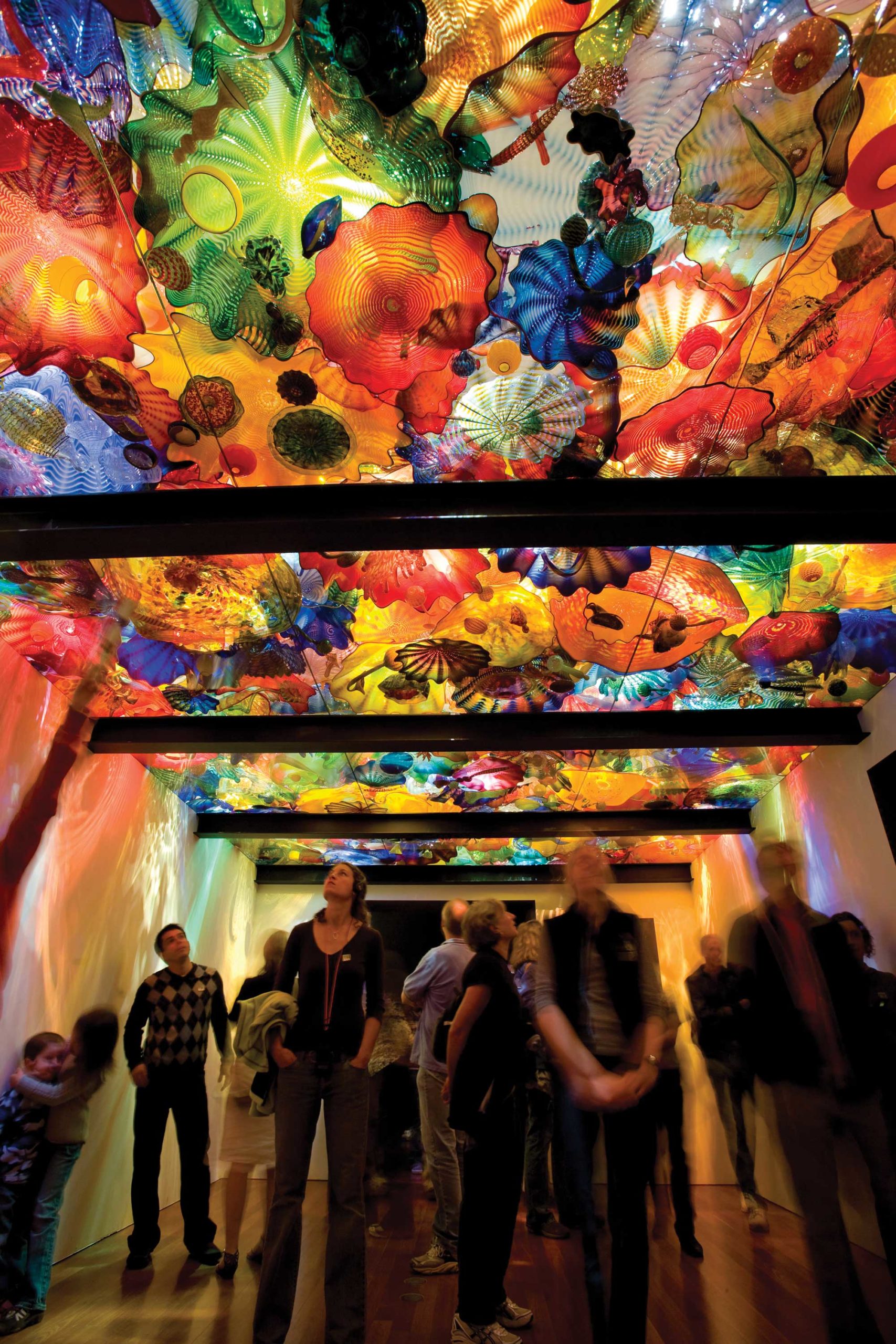
Today Chihuly’s art can be found in more than 200 museum collections worldwide, and Chihuly Studio has become an entrepreneurial juggernaut that distributes enormous quantities of editioned glass works, editioned prints made after his gestural drawings, colorful blankets and scarves bearing his designs, substantial books, and eye-catching posters. This output has never wavered in quality since my first encounter with the studio in 1996 when I helped (as a junior administrator) present a hugely popular Chihuly exhibition at the Baltimore Museum of Art.
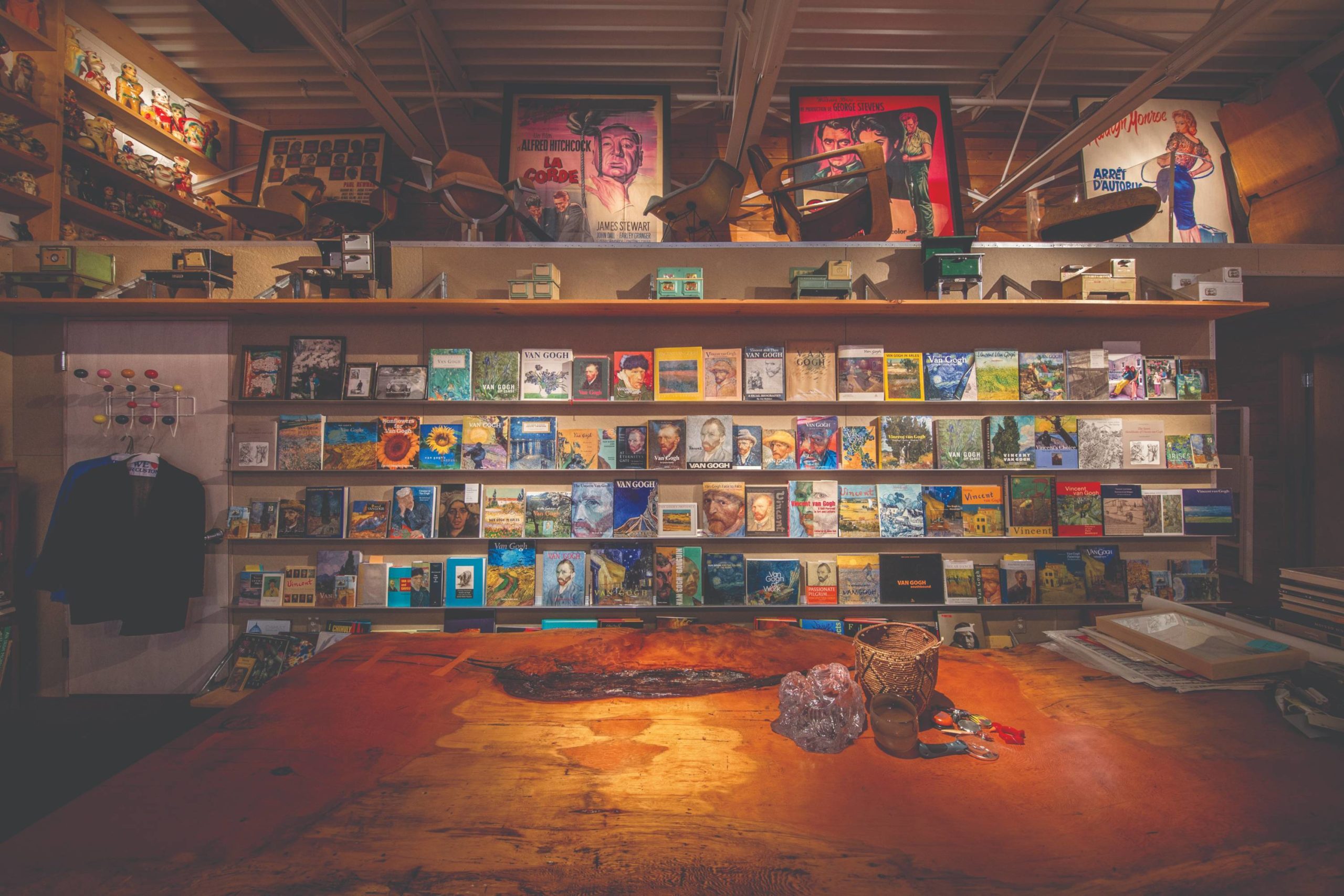
In February 2020, the leaders of Chihuly Studio kindly invited me to Seattle to see what they were doing nearly 25 years later. My first pleasant surprise was exploring Chihuly Garden and Glass, a long-term exhibition located at the foot of the iconic Space Needle. Inside is a suite of galleries introducing Chihuly’s career through eight impressive room-installations accompanied by helpful videos of the artist and his hot-shop team at work. The visit culminates with ogling a 100-foot-long arrangement hung from the ceiling of a 40-foot-high glasshouse, then strolling through a garden featuring more installations and a pavilion offering live glass-making demonstrations.
Unlike the public, I was also invited to the Boathouse, the large complex facing Lake Union where Chihuly supervises his energetic glass-making team in the hotshop. Finally, I visited the administrative headquarters of Chihuly Studio, which contains a by-appointment gallery for top clients and a high-ceilinged warehouse where every commissioned project is tested before shipment to the client.
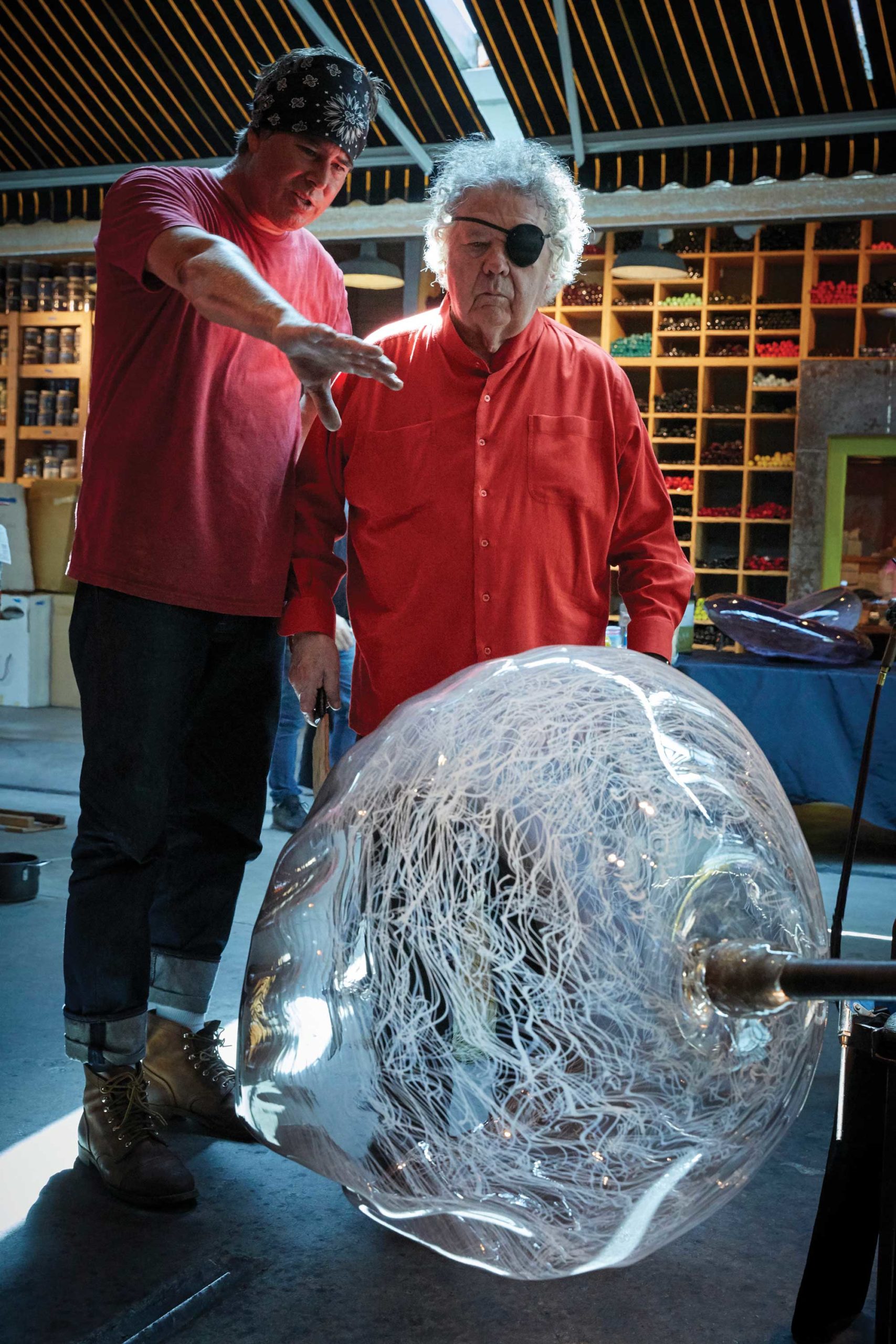
Sometimes when I already know and like something, I stop seeing it clearly. I have always admired Chihuly’s works in glass, but the Seattle visit reminded me of how essential it is to move around his deftly arranged massings of them — better yet, through them. This trip showed me that half of Chihuly’s artistry relates not to glass but to his brilliance in presenting it. The latter owes much to his early training in interior design and architecture (I had no idea), and also to how he arranges, and lives with, his own collections of art and artifacts. (Again, I had no idea.)
Always Innovating
It helps to review how Chihuly got here. During his first year attending the University of Puget Sound in his hometown of Tacoma, he successfully remodeled his mother’s recreation room and enjoyed the experience so much that he decided to pursue architecture and interior design at the University of Washington in Seattle. In a weaving class, he incorporated glass shards into woven tapestries, signaling an alertness to boundary-crossing that became evident later. In 1965, Chihuly earned his B.A. in interior design, confident enough of his ability to conceive, draw, and fill up spaces that he later worked for a Seattle architecture firm (briefly).
The young man had already caught the glass bug, however, so in 1966–67 he earned an M.S. at the University of Wisconsin (Madison) while studying glassblowing under Harvey Littleton, who had launched America’s first glass program there. The next academic year was spent earning an M.F.A. at the Rhode Island School of Design (RISD) in Providence, where Chihuly began exploring environmental works using neon, argon, and blown glass. This led to a Fulbright fellowship allowing him to become the first American blower to work in the hotshop at Venice’s famous Venini glass factory. There he observed the team approach to blowing glass, not the solo approach normally used by Americans that kept the scale of their creations modest. (The more people lifting and turning the molten glass, the larger the pieces to be made.)
In 1969, Chihuly established RISD’s own program in glass and taught there for 11 years. Two years later he co-founded the Pilchuck Glass School, an hour north of Seattle and initially envisioned as a summer-only program. The rest is history, as Pilchuck’s (and Chihuly’s) success has since transformed the Pacific Northwest into America’s leading regional hub for glass art. That summer, Chihuly created his first environmental installation featuring glass objects floating on water. At RISD the following year, he partnered with James Carpenter to make the installations “20,000 Pounds of Ice and Neon” and two “Glass Forests,” and in 1971 their collaborations were shown at New York City’s Museum of Contemporary Crafts.
Though he was spending most of the year on the East Coast, Chihuly was still very much a Westerner. In 1975, he began the Navajo Blanket Cylinder series, and the following year three examples of it were acquired by New York’s Metropolitan Museum of Art. Naturally this breakthrough encouraged Chihuly; in 1977, his Basket series was inspired by a visit to the Washington State Historical Society in Tacoma, where he admired Northwest Coast Indian baskets that seemed to be slumping under their own weight.
Later that year he exhibited “100 Pilchuck Baskets” at the Seattle Art Museum on a steel table. Like their inspirations, most were monochromatic and only a few were asymmetrical, but that soon changed: Chihuly became more comfortable allowing gravity, centrifugal force, and the fire’s heat to form Baskets with undulating walls. This willingness to “let go,” and a shift toward brighter and more diverse coloring, was an inheritance from Jackson Pollock and other abstract expressionists, whose randomness Chihuly had long admired.
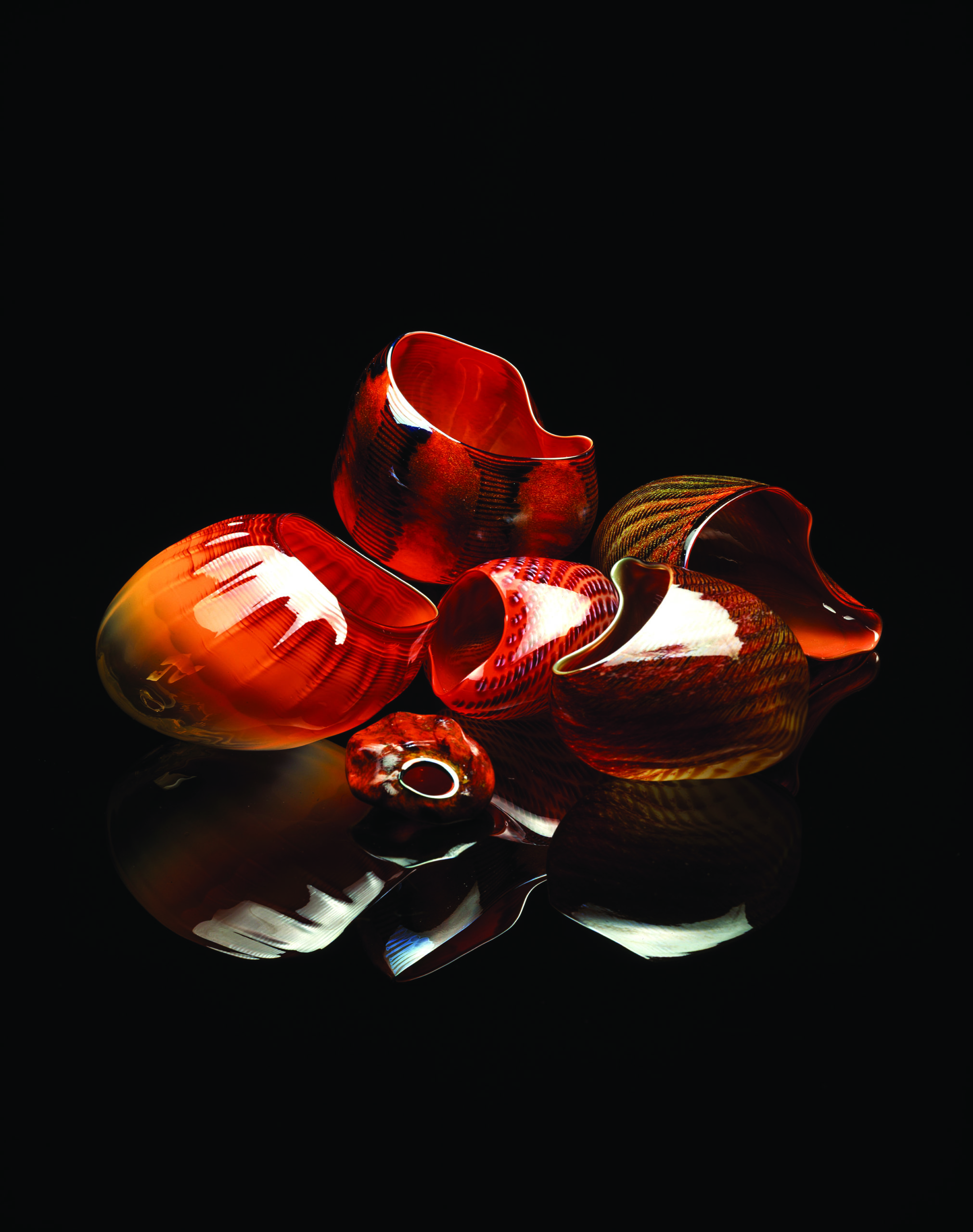
In the late ’70s, Chihuly began thinking about space in new ways. Influenced by the Standing Stones of Stenness — a site he had visited in the Orkney Islands — he assembled mini-installations (what he calls “sets”) of smaller glass pieces that fit into and around a larger one. This impulse took on new energy in 1980 with the Seaforms, baskets that began to resemble shells, and a year later with the Macchia, spotted baskets he massed on tabletops and pedestals as Macchia Forests. (Their name was coined by his sculptor friend Italo Scanga [1932–2001] because “macchia” means “stain” in Italian.)

Other expressions of his desire to activate space include his windows for Shaare Emeth synagogue in St. Louis (1980) and sets for two musical productions (Debussy’s Pelléas et Mélisande, Seattle Opera, 1992; and Bartók’s Bluebeard’s Castle, Seattle Symphony, 2007).
In 1985, Chihuly began making glass in vaguely ancient forms with the Persians series. These were often wall-mounted or stacked on shelves and wall cases, and soon he was setting them onto pergolas through which viewers look up; they can even be found under plate glass at the bottom of his own lap pool. From his training in design and architecture, Chihuly knew how to light for maximum impact, and also which wall colors boost the intended effects.

The significance of light took center stage in 1992, when Chihuly launched his Chandelier series with an exhibition at the Seattle Art Museum; four years later, the first permanent outdoor one was inaugurated in Leavenworth, Washington. In 1996, he realized a personal dream to install 14 Chandeliers over the canals and piazzas of Venice. Planning for that project got underway in 1994, just as Christo and Jeanne-Claude were famously wrapping Berlin’s Reichstag in silver fabric. During his visit with them there, Chihuly was deeply impressed by the ambition and public-spiritedness of their mega-installation and adapted some of their strategies for Chihuly over Venice.
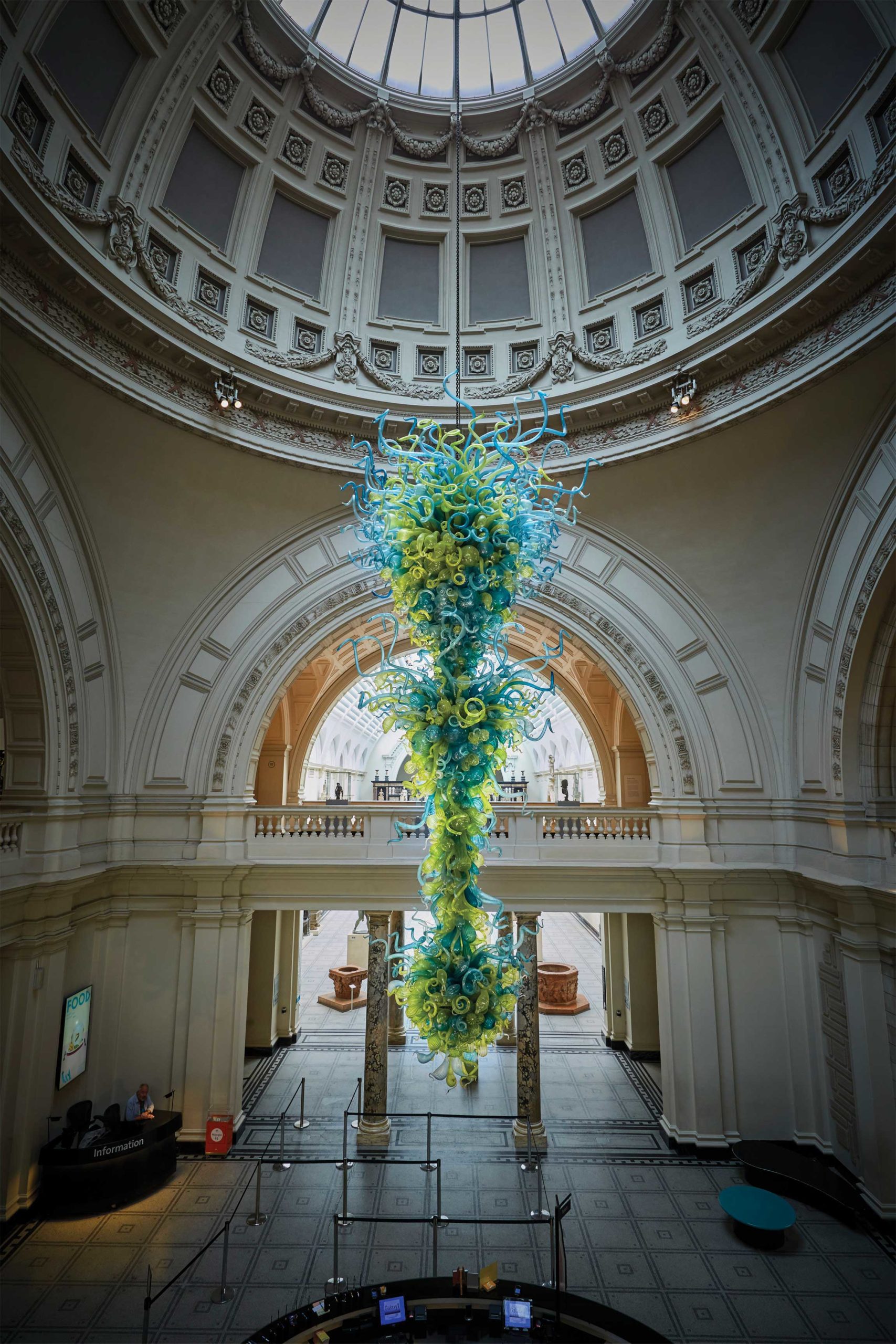
A new chapter opened in 2001 at Chicago’s Garfield Park Conservatory. This was the first of many interventions in botanical venues worldwide, where Chihuly’s organic forms interact well with those of nature. The latest such presentation is on view at Nashville’s Cheekwood Estate and Gardens (July 18, 2020–January 10, 2021).
Chihuly continues to innovate. Around 2019 he experimented with a Venetian cane-working technique called merletto (“lace”). He departed from its customary precision in order to convey a more expressive energy by applying mesh-like drawings of white cane glass onto his Baskets. “This series mimics the feel of lace, the way it moves and drapes easily into soft forms,” he explains.
Chihuly Studio CEO Leslie Jackson Chihuly sees Chihuly Merletto as “another example of how Dale continues to explore the medium of glass and stretch his vocabulary through new ideas and old techniques.” The fruits of this labor can now be enjoyed on Traver Gallery’s website, which presents the glass works alongside his drawings for them.
Dale Chihuly – His Own Little Museum
Chihuly’s knack for arranging things also stems from his parallel life as a passionate acquisitor. “When I start to collect something,” he says, “I often don’t start with a single object. Sometimes I start with 10 or 20 or a hundred. It is like creating my own little museum.” Chihuly carefully organizes and catalogues his discoveries, then displays them with dramatic flair. During my visit I was delighted to find every corner of the Boathouse adorned with collections; there’s a lot to see, but it doesn’t feel like an episode of Hoarders.
Like much of his generation, Chihuly started by gathering stamps, then anything automotive (actual or miniature). Having grown up in the West, he has an affinity for historic Native American baskets and blankets, hand-carved canoes, and the sepia-toned photogravures of Native Americans taken by Edward S. Curtis (1868–1952). It also makes sense that a master of glassmaking collects ancient handblown glass, primarily from the heyday of the Roman Empire: “I love the patina that only time and age can give the surface of an object,” Chihuly notes.
This artist is an unabashed fan of other artists. His private rooms contain entire walls covered with art books with their attractive covers facing out; one features more than a hundred volumes devoted to Vincent van Gogh, though Chihuly also admires Winslow Homer, Charles Demuth, and John Marin, among other historic masters.
The bulk of the collections, however, have little to do with fine art: “I love to find the beauty in everyday objects,” Chihuly notes. Thus there are enormous holdings of accordions (which his father and brother played); album covers; anonymous black-and-white photographs; bottle openers; cameras; cast iron doorstops; chairs (primarily from the mid-20th century); dollhouse furniture; fishing decoys; inkwells; juicers; kitchen-related items, including children’s tin stoves and Fiestaware ceramics; matchbooks; paperweights; papier-mâché masks; pocketknives; postcards; posters; radios; shaving brushes; toy soldiers; and much more. And the quest continues: “I’m always looking,” Chihuly admits.
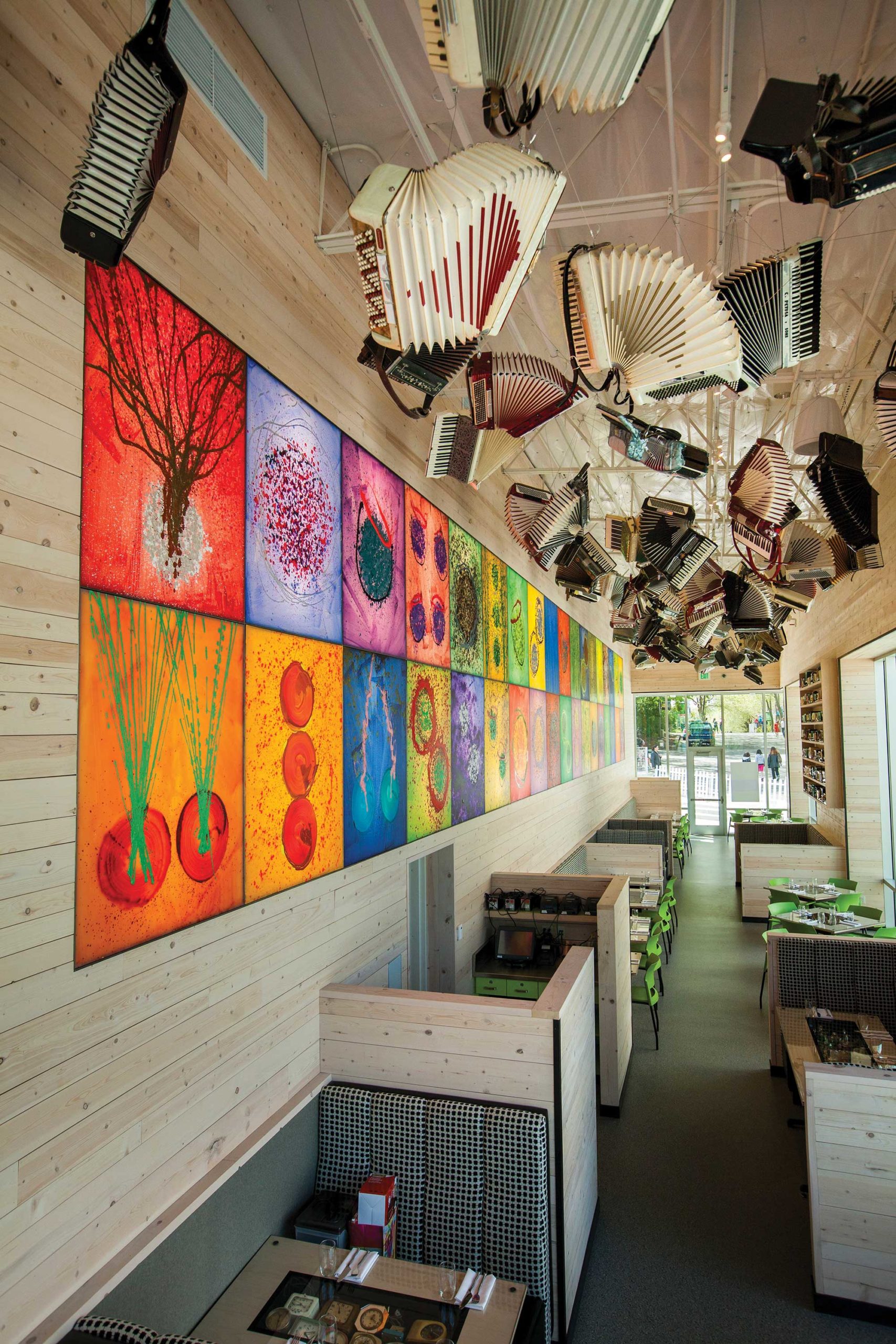
Dale Chihuly was already an enthusiastic collector in 1967 when he began a lifelong friendship with Italo Scanga, who made neo-Dadaist assemblages of found objects. Visiting flea markets was their inexpensive hobby, a pastime also pursued by another RISD faculty member, the painter Richard Merkin. Yet another role model for voracious collecting was Andy Warhol, with whom Chihuly traded artifacts. The two met in 1970 when the Manhattan-based pop artist curated a show at RISD’s museum titled Raid the Icebox 1. This necessitated Warhol’s rummaging through the permanent collections during five visits to campus; ultimately he exhibited an array of half-forgotten items from the storerooms including shoes, chairs, parasols, wallpaper, hatboxes, Native American blankets, and more.
So why does Chihuly’s mélange of masterworks and detritus matter? “My collections inspire me and are often a source for new ideas,” he replies.

Most importantly, the arranging of collections both informs and benefits from Chihuly’s concurrent arranging of glass. In 2017 his artist friend Bruce Helander published a richly illustrated book, Chihuly: An Artist Collects, that offers a glimpse inside. He wrote that Chihuly’s glass art is “irrefutably about beauty, craftsmanship, and contour, as well as the aesthetics of repetition and organization (cultivation) of a collection of handblown objects that are all different, but are strongly connected by a universal trait.” Indeed, Chihuly’s gorgeous glass works would be less impactful without his deft contrasting of their distinctions and similarities through placement and lighting.
My stroll through room after room of Chihuly’s bottle openers, fishing decoys, and matchbooks could have been a claustrophobic ordeal, but it became a visual revelation thanks to the eye that had ordered them. I may never need to see another toy soldier, but am already anticipating my next immersion in a room of Chihuly’s glass.
View more artist and collector profiles at FineArtConnoisseur.com.

